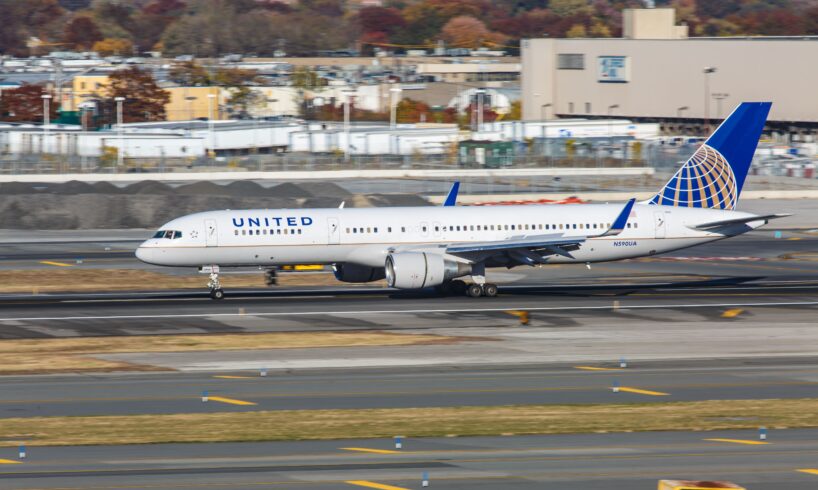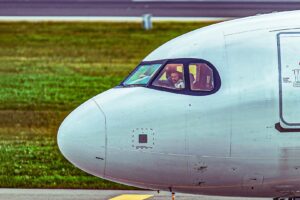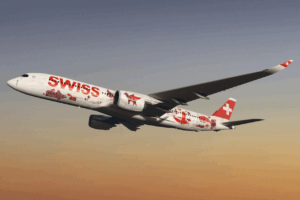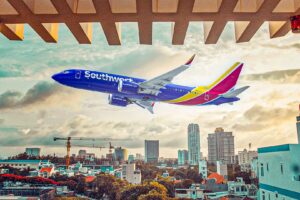
United Airlines has had a long and tumultuous history at New York John F. Kennedy International Airport (JFK), including an initial run of several decades before it returned to the airport for a year and a half in 2021.
IATA/ICAO Code
JFK/KJFK
CEO
Rick Cotton (Executive Director of Port Authority of NY and NJ)
Passenger Count
16,630,642 (2020)
With the newly announced partnership with JetBlue, called Blue Sky, United Airlines traded eight flight timings for slots for up to seven daily round-trip flights out of New York-JFK. As early as 2027, the airline should return to New York’s largest airport, dominated by SkyTeam and its airlines, including Delta Air Lines.
Third Time’s A Charm?
Photo: Xackery Irving | Shutterstock
On May 29, United Airlines and JetBlue announced a partnership, called ‘Blue Sky.’ Scott Kirby, the Chief Executive Officer (CEO) of United Airlines, said about the partnership that it reflected the two carriers’ joint focus on innovation and customer experience.
The partnership, which could be dissected into several different aspects, including the swap of slots and flight timings at New York-JFK and Newark Liberty International Airport (EWR), frequent flyer benefits, and United Airlines using JetBlue’s technology platform and vice-versa, was describeed as a bold step for the industry by Joanna Geraghty, the CEO of JetBlue.
Nevertheless, Kirby stated that the JetBlue brand is synonymous with a great product, with the executive praising Geraghty and her leadership of the airline, which continues to deliver for its customers.
“We’re always looking for ways to give our MileagePlus members even more value and benefits, and this collaboration gives them new, unique ways to use their hard-earned miles and find options that fit their schedule.”
Exciting Return To JFK
Photo: Vincenzo Pace | Simple Flying
Kirby concluded his statement that United Airlines’ employees are “really excited” about the airline’s return to New York-JFK “for the long term,” with the CEO adding that the carrier is looking forward to starting up flights very soon. The partnership entails JetBlue giving United Airlines slots for up to seven daily round-trip flights in exchange for eight flight timings at Newark Liberty International Airport (EWR).
According to the Federal Aviation Administration (FAA) documents, during the summer 2024 season, which ran from March 31, 2024, to October 26, 2024, JetBlue had the second-highest number of slots at New York-JFK, with 359, trailing Delta Air Lines with 483. Surprisingly, United Airlines had one.
Speaking with CNBC after Blue Sky was announced, Kirby explained that the partnership will not only allow United Airlines to return to the airport with its own metal – aircraft – but also with the added benefit of a partner in the form of JetBlue, with which United Airlines signed an interline agreement that includes frequent flyer benefits (earning and using miles). Unlike JetBlue’s attempted Northeast Alliance (NEA) with American Airlines, Blue Sky will not be a codeshare agreement, with the two airlines maintaining their independence in scheduling, pricing, and network.
Related
How The End Of The NEA Forced American Airlines & JetBlue To Change Their Networks
American Airlines and JetBlue have made significant cuts to their Northeast networks after their loss to the DOJ in the courts in May 2023.
Inability To Grow At JFK In 2022
Photo: Leonard Zhukovsky | Shutterstock
The last time United Airlines was present at New York-JFK was in 2022. Around a year after the pandemic gripped the world, the airline returned to New York’s largest airport on March 28, coinciding with the beginning of the International Air Transport Association (IATA) summer 2021 season, operating departures to Los Angeles International Airport (LAX) and San Francisco International Airport (SFO).
Spoiler alert: the airline, while it did scale up its New York-JFK operation to double-daily departures – one each to Los Angeles and San Francisco, its major West Coast hubs – United Airlines could not grow, and that is why it left. In a leaked letter to the carrier’s employees in September 2022, which was obtained by Reuters, the carrier said that for more than a year, it had pursued additional slots through the FAA and the industry market so that it could grow at New York-JFK and become more competitive at the airport.
Photo: Great Circle Map
“Without permanent slots, we cannot serve [New York-JFK] effectively compared to the larger schedules and more attractive flight times flown by our competitors,” the letter read, adding that JetBlue, at the time, had up to five times the number of daily departures compared to its own schedule. According to data from the aviation analytics company Cirium’s Diio Mi airline planning tool, in September 2022, four airlines had 202 weekly departures from New York-JFK to Los Angeles. JetBlue had 66, American Airlines had 63, Delta Air Lines had 49, and United Airlines had 14 departures to the California airport. In June, there are 208 weekly departures from the East Coast airport to the West Coast airport, scheduled by JetBlue (73), Delta Air Lines (65), American Airlines (63), and Frontier Airlines (seven).
Meanwhile, between New York-JFK and San Francisco, September 2022 had 149 one-way weekly departures, with flights being offered by JetBlue (39), Alaska Airlines (35), Delta Air Lines (34), American Airlines (27), and United Airlines (14). In June, one-way weekly departures should dwindle to 134, including departures being filed by Delta Air Lines (45), JetBlue (40), American Airlines (AA), and Alaska Airlines (21).
“If you recall, United had an opportunity during COVID to gain access to some temporary slot times at JFK held by other airlines,” the letter continued. “Now that customer demand has surged back, the operators of these slots are resuming their use at the start of the winter season and beyond.” As a result, in October 2022, it operated its last flights from/to New York-JFK. The airline confirmed that it would exit the airport on September 30, 2022, saying that given its current small schedule out of New York-JFK, which were operated by Boeing 757-200 aircraft on both of its routes, it “has made the difficult decision to temporarily suspend service at New York-JFK,” according to another internal memo, as reported by The New York Times.
Between September 2022 and November 2022, the number of weekly flights it offered from Newark to Los Angeles and San Francisco grew by 12, to 111, including 55 weekly departures to Los Angeles and 56 to San Francisco. Flights were operated by 757, 777-200, 777-300ER, and 787 (787-9 and 787-10, to Los Angeles only), Cirium’s Diio Mi showed.
Initial New York-JFK Exit In 2015
Photo: Markus Mainka | Shutterstock
After decades of operating from New York-JFK, United Airlines decided to wave goodbye to the airport in 2015, with its last flights until 2021 being operated on October 24, 2015. Unsurprisingly, these were also to Los Angeles and San Francisco, which were the only two destinations from New York-JFK since October 2014, when United Airlines also ended flights to Washington Dulles International Airport (IAD), its other hub on the East Coast of the US, with the other being Newark.
United Airlines, despite having had a major presence at New York-JFK, had continued to reduce its schedule at the airport throughout the early 2000s. Since October 2006, its only three destinations from the airport had been Los Angeles, San Francisco, and Washington Dulles. Since at least 2000, its peak schedule from the airport was between January 2000 and June 2000, when, during each month of the period, it had 282 weekly departures from the airport. In May 2000, for example, it had flights to 11 destinations, displayed below.
Photo: Great Circle Map
Since then, United Airlines’ route network at New York-JFK had been gradually reduced to around 150 weekly departures in 2006. In October 2006, the airline’s network from the airport had five destinations: London Heathrow Airport (LHR), Los Angeles, San Francisco, Tokyo Narita International Airport (NRT), and Washington-Dulles. During the same period, United Airlines had also reduced its flying from Newark, going from 338 weekly departures in May 2000 to 139 weekly departures in October 2006. However, between the latter month and October 2015, when it ended flights from New York-JFK, its Newark weekly departures grew to a whopping 2,681. That scale-up does sound made-up, but the Continental Airlines and United Airlines merger concluded on March 3, 2012, with the former having had a major presence in Newark before the merger, while the latter ended up being the surviving entity.
Photo: Great Circle Map
Nevertheless, when United Airlines officially announced its exit from New York-JFK, and its shift of ‘Premium Service (p.s.)’ 757-200 service from the airport to New Jersey (Newark), it said that now, passengers flying on transcontinental flights from/to Newark in the BusinessFirst – now known as Polaris – would, “for the first time, enjoy flat-bed comfort for their entire journey when connecting to and from flights across United’s extensive trans-Atlantic and trans-Pacific networks.”
It is clear that to this day, United Airlines really values the transcontinental flights between both coasts of the US. In June, out of the 2,851 weekly departures from Newark, 103 are scheduled to San Francisco and 92 are to Los Angeles, according to Cirium’s Diio Mi. Collectively, that is 6.8% of the airline’s total weekly departures from the airport during the month.
Betting Man’s Perspective
Photo: Robin Guess | Shutterstock
What does the future hold for United Airlines at New York-JFK? While only time will tell, with the carrier planning to begin its operations from the airport in 2027, if I were to become subjective for a moment, and to put myself in the shoes of a betting man, I would guess that the first two destinations would be Los Angeles and San Francisco.
Cirium’s Diio Mi data, citing the Department of Transportation (DOT), showed that during 2024, American Airlines, Delta Air Lines, JetBlue, and other airlines carried over 3,300 passengers per day between New York-JFK and Los Angeles. To San Francisco, the trio, with the addition of Alaska Airlines, carried over 2,200 daily travelers. Load factors on these two routes averaged around 89% in 2024.
Could United Airlines now succeed at New York-JFK? It seems unlikely that United Airlines would enter into a partnership that includes reducing its flight timing portfolio at Newark, just so it can take another stab at succeeding at New York-JFK without a long-term plan. Even if the airline will only have slots for two routes from the airport, one could only assume that it would try to out-compete the incumbents within the premium segment on transcontinental routes. After all, at least in Kirby’s view, the US airline industry has the capacity to have two successful premium airlines, according to comments he made during the J.P. Morgan Industrials Conference.
“Well, the first time I actually remember saying that [there is room for two premium airlines in the US] was 12/09/2013, which was the day the American Airlines U. S. Airways merger closed,” Kirby said. “The airlines decided to flip the playbooks, but I still think there’s only room for two. It’s just the size of the market,” according to the CEO of United Airlines, who said that even the big metro areas can only support two, with the comments being interpreted as a swipe at American Airlines, one of the airlines currently flying between New York-JFK and Los Angeles and San Francisco.






